Paris officials want Phase 2 of the Future Combat Air System agreed with Berlin and Madrid before year-end, with a fighter demonstrator plan included in that package. The ministry described the target as a “mutually acceptable solution.”
France, Germany, and Spain repeated support for the program in September while acknowledging the dispute over who leads the crewed fighter, the New Generation Fighter. The French side pressed for stronger industrial leadership to keep the 2040 in-service date within reach.
A Phase 2 framework would define the demonstrator schedule and the split of work on the fighter, remote carriers, sensors, and the combat cloud. Industry timelines now in circulation place a first flight for the demonstrator near 2029, if contracts and test assets line up this winter.
Berlin and Madrid signaled they will not abandon the trilateral structure without exhausting talks. Germany’s leadership called for sticking to existing understandings on work division. Spain underlined its adherence to the original plan and pushed partners to close the text this year. A meeting in Berlin in October is expected to set the final negotiation track.
French industry took a harder line in late September. Dassault Aviation’s chief executive said the company can build a next-generation fighter alone if needed and repeated the demand for clear design authority on the crewed aircraft. He added it remains a government call, not an industrial one. Airbus, which represents Germany and Spain on the fighter elements it owns, has pushed back and accused the French side of slowing progress on the demonstrator phase.
German leaders and officials offered mixed messages on fallback options. Reports described work in Berlin to test alternatives with partners outside the current trio, including the UK-led Global Combat Air Programme or a pairing with Sweden. The defense minister countered those reports in public and said there are no government talks on such moves, while confirming that a go-forward decision must come this year.
Spanish leaders stayed on message through September. Prime Minister Pedro Sánchez told reporters after meeting the German chancellor that the agreed work plan must be respected. Spain’s defense minister stressed the European nature of the project and its link to national industrial policy, and officials pointed to the country’s role via Indra.
Analyses from Paris-based and German outlets this week described a program in danger if Phase 2 slips into 2026, citing sunk costs and the long test cycle for a clean-sheet fighter. Those pieces tie risk to unresolved governance on the fighter design office and the flow-down of intellectual property between the teams.
Readouts from the Madrid press event in mid-September show both leaders stressing cooperation, European security, and the need to make progress without detailing the fix for the fighter leadership row. The public remarks kept the temperature down even as industry rhetoric rose.
Defense officials confirm an October trilateral session in Berlin to attempt a package that would lock design authority for the fighter, set handoffs between the fighter and remote carriers, and approve demonstrator funding lines. The same officials expect progress on how flight-test assets will be shared and how mission-system labs will be staffed during 2026.
Industrial Design Authority Dispute
The French position inside government circles still favors a strong prime contractor on the crewed fighter. The rationale given to lawmakers and press is simple enough: one design office and one chief engineer for the aircraft to avoid churn, while partners lead their own pillars. According to industry sources, firms in Germany argue that this stance undercuts the basic bargain of a trinational program and reduces returns for German suppliers, especially on structure, flight controls, and avionics.
Airbus managers have promoted a different approach for months. They want a detailed work matrix under an equal-vote model and guardrails on supplier selection so no team locks out the others from key systems. The language that surfaced in June about “proper rules of engagement” is a coded way to say who gets to pick second- and third-tier vendors on large subsystems.
French industry arguments lean on track records. Dassault points to a long run with Rafale and Mirage, and claims the fastest path runs through a single accountable lead for the fighter, with full access for partners to their agreed work. The company’s public remarks also hint at a bottom line: if the structure cannot deliver, Paris can still fund a national path. That line landed days before the latest government reassurance about finding a trilateral fix by December.
National Political Positions
Germany’s political calendar complicates the window. A new chancellor and a coalition reshuffle put fresh advisers into defense and industrial posts. The chancellery has used public comments to insist on fairness in work division and on sticking to signed understandings. That helps Berlin’s case at home with unions and suppliers, which want predictable returns over the next decade.
Spain’s calculus differs. Madrid positions itself as the balance wheel that keeps a European fighter on track while its own air-force recapitalization proceeds with Eurofighter upgrades. Government remarks from late summer also pushed back on the idea of buying U.S. fighters as a hedge reinforcing the line that Europe should finish what it started with FCAS.
The state of play this week shows conflicting signals on alternatives. British press and briefings floated the idea of Berlin joining the UK-Italy-Japan program in some capacity. Other commentary speculated on a Swedish link. Official denials from Berlin and Stockholm followed within days, which suggests those ideas remain exploratory rather than negotiated.
Public numbers vary, but a ballpark figure of €100 billion for the long program life cycle appears across recent reports. Several pieces also cited investment to date in the low single-digit billions. Those ranges are consistent with the size of a clean-sheet fighter with adjunct systems and a multi-year development arc.
The program spans a networked architecture with a crewed fighter at its core and several unmanned systems. Nobody disputes that structure. The question negotiators must settle is how the three partners divide authority across the aircraft, mission systems, the cloud, and the loyal-wingman class, and who holds the pen when requirements clash.
Press accounts in September said German officials explored options to proceed without France if talks fail. The defense minister then pushed back and said any decision on the program’s future will be made this year with France and Spain. The juxtaposition tells the story of a government testing leverage while keeping the door open.
Spain’s latest public steps sit closer to France than to Germany on tone, not on process. Madrid’s line about respecting the original plan, together with continued funding for national industry inside FCAS, signals a preference to avoid a split while keeping the design office issue on the table. That stance buys time for a package deal and protects Spanish positions in sensors and integration.
Way to Demonstrator
A narrow set of decisions can unlock the demonstrator. The governments need to confirm a chief designer for the fighter, settle the interface control documents between the fighter and remote carriers, and approve a joint test plan that shares flying assets and labs by early 2026. Suppliers then get the predictability to hire and tool. According to industry sources firms also want a fast ruling on intellectual-property access so model-based design work can move between national teams without roadblocks.
Financial commitments will come in tranches once the governance items close. A demonstrator program typically pulls hardware spending into avionics, structures, engines, and flight-test support across three to four years. That aligns with a late-decade first flight, assuming long-lead items get authorized this winter. The partners know delays in that sequence cascade into lab occupancy and range time.
Quotable lines from September illustrate the gap. “We can’t continue as things are,” the German chancellor said after meeting Spain’s leader in Madrid. The French industry lead responded the next week that his company can proceed alone if needed, while insisting he prefers a European path with clear leadership on the fighter. Spain’s prime minister answered that the original plan stands.
A small set of near-term markers can show whether a deal is within reach: A published communique after the October Berlin meeting that names the fighter design authority and lists the responsible teams for remote carriers and the cloud. A target month for demonstrator contract award, with a year for first flight that aligns with the resource plan released to industry.
Europe’s previous fighter split still haunts this file and not only as a history lesson. The Rafale-Eurofighter divergence decades ago followed a breakdown over control and operational requirements. The present dispute echoes the same issues in a different industrial landscape, with export markets tighter and software content larger than in the 1980s.
Signals from London add pressure without settling anything. Commentators close to the UK program mention Berlin could join in some form if it left FCAS. That idea would need buy-in from all GCAP partners and would still raise the same questions about work division and leadership that FCAS faces today. The denials from Berlin suggest that, for now those stories function more as leverage in a hard negotiation than as a real pivot.
The outcome hinges on governance clarity for the crewed fighter and the speed of a demonstrator award. If the partners settle the chief designer, supplier selection rules, and data-sharing across the labs this quarter Phase 2 can start without a structural change in the partnership. If not, national options will harden and the program will bleed calendar in 2026.
Phase 2 decision by year-end 2025 and fighter demonstrator targets
French officials and industry boards now align on the need to sign Phase 2 before December closes. The demonstrator needs long-lead hardware in 2026 to make a late-decade flight. Test-range scheduling, airworthiness planning, and the certification path for mission systems all depend on that start. A slip into next year would hit hiring and tooling plans immediately.
Ministries expect to publish a refined work package list once the October talks finish. The set will cover the fighter, remote carriers, the network layer, and a shared mission-system lab construct. The governments will have to assign single-point accountability for the fighter while preserving national leadership on other pillars.
Dassault Airbus workshare dispute and design authority positions
Dassault wants undisputed design authority for the crewed fighter and a clear chain for supplier selection on major subsystems. The company argues the aircraft cannot tolerate split leadership at the top of the design office.
Airbus counters that a balanced model with defined rules and equal votes protects national returns and unlocks access for German and Spanish suppliers on structure, control systems, and avionics. Both sides claim they can move fast once the rules settle.
Late September interviews hardened positions in public. Dassault’s chief told reporters his firm can build a fighter without partners, then added he still seeks a European program with clear leadership. Airbus sources framed the remark as pressure and insisted the next step should be signing the demonstrator under the existing equal-vote model.
German and Spanish government statements in September 2025
Germany’s leadership urged partners to stick to prior understandings and warned that prolonged uncertainty endangers Phase 2 this year. The same leaders kept options open in background briefings, which fueled stories about alternatives. Public lines from the defense ministry denied any talks with the UK or Sweden and promised a decision with France and Spain in 2025.
Spain’s prime minister told press the original plan must be respected. His government linked that stance to broader European security and to national industry roles inside FCAS. Spain’s defense minister echoed the call for joint work and against fragmentation.
Fallback options: GCAP or Sweden?
Briefings and media reports described London’s openness to Germany joining the UK-Italy-Japan fighter effort in some capacity. Other pieces floated a Swedish path if the current trio cannot agree this year. Those stories met hard denials from Berlin and from Stockholm’s side on any active talks. The timing aligns with a leverage play before ministers gather in Berlin.
Analysts in Europe warned this week that FCAS risk grows if the partners miss the 2025 window for Phase 2. They point to years of work on labs and early technology and to the political cost of a split after heavy investment.
REFERENCE SOURCES
- https://www.yahoo.com/news/articles/britain-prepared-let-germany-join-150000097.html
- https://www.defensenews.com/global/europe/2025/09/22/france-seeks-mutually-acceptable-accord-on-next-gen-fighter-progress/
- https://www.reuters.com/business/aerospace-defense/frances-dassault-aviation-says-it-could-build-new-fighter-jet-alone-if-needed-2025-09-23/
- https://www.reuters.com/business/aerospace-defense/no-talks-between-germany-uk-sweden-fighter-jet-german-minister-says-2025-09-23/
- https://www.reuters.com/business/aerospace-defense/merz-urges-france-stick-deal-joint-fighter-jet-project-2025-07-09/
- https://www.bundesregierung.de/breg-en/news/statement-chancellor-madrid-2385182
- https://www.lamoncloa.gob.es/presidente/intervenciones/paginas/2025/20250918-transcripcion-rueda-prensa-sanchez-merz.aspx
- https://www.ft.com/content/29f56fd5-d831-43a2-b7be-216918231f09
- https://www.telegraph.co.uk/business/2025/09/27/britain-prepared-let-germany-join-next-gen-fighter-jet/
- https://breakingdefense.com/2025/09/germany-and-sweden-not-discussing-fcas-partnership-say-defense-ministers/
- https://dsm.forecastinternational.com/2025/09/30/trilateral-fcas-program-at-a-crossroads-amid-workshare-dispute/
- https://www.flightglobal.com/defence/airbus-dassault-tensions-rise-over-phase-2-workshare-for-fcas/163490.article
- https://www.france24.com/en/live-news/20250924-france-doubles-down-on-threat-to-build-future-fighter-jet-alone
- https://www.lemonde.fr/en/international/article/2025/10/03/french-german-future-combat-aircraft-project-on-the-brink-of-collapse_6746036_4.html
- https://militarnyi.com/en/news/uk-ready-to-allow-germany-to-join-sixth-generation-tempest-fighter-jet-project/



